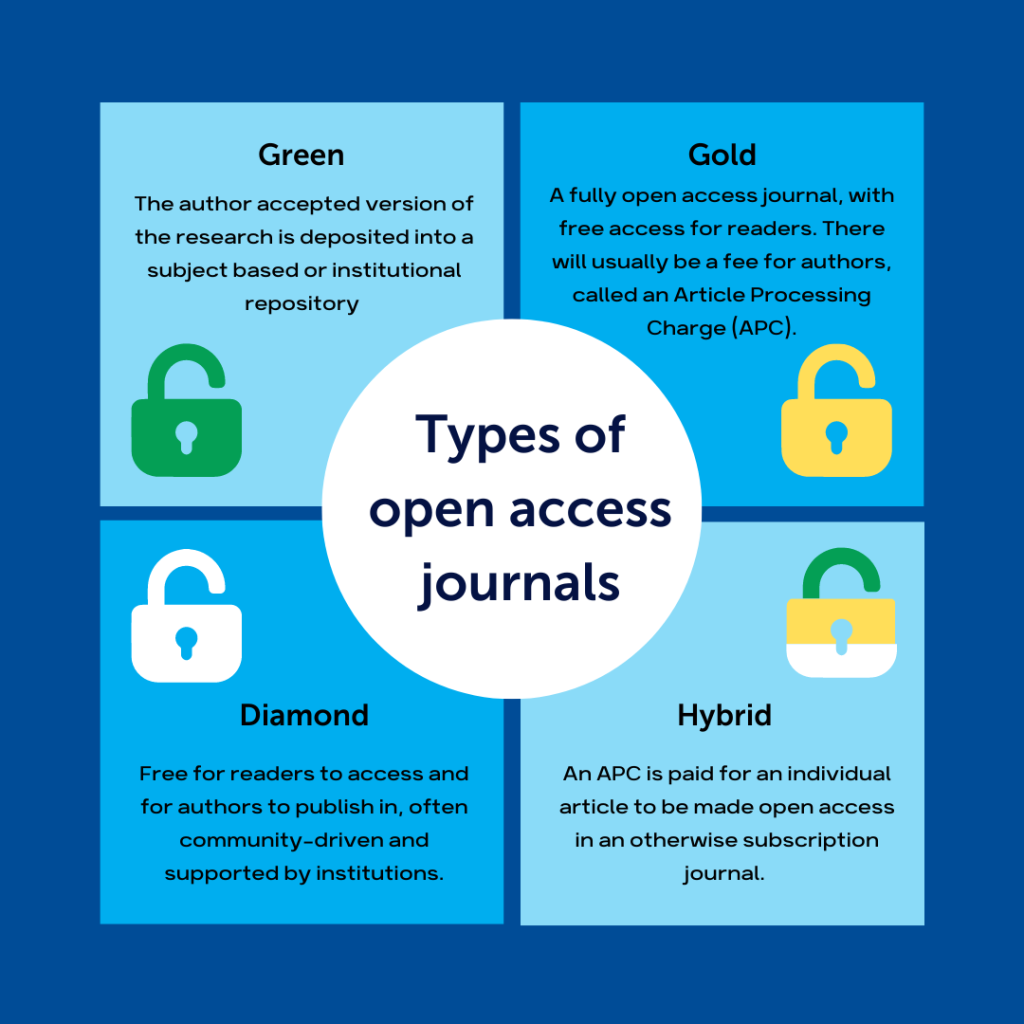Publishing
Learning Objectives
This chapter will help you:
- understand the academic publishing process.
- decide which journal to publish in.
- understand the benefits of publishing Open Access.
- identify reputable journals and publishers.
“…with the significant increase in the number of journals, and journal types, and changes in the coverage and standing of some established journals, it is difficult for even experienced researchers to make sound journal choice decisions.” (Rowley et al., 2022, p. 321).
Congratulations, you have completed your review!! The final stage is publication in a peer reviewed journal. There are a huge number of these and choosing where to publish your review can be daunting.
What to expect in the publishing process
It can take a long time from the submission of your review to being published in a journal, sometimes over a year.
Activity 16
Choosing a journal
To help choose journals to target for your review, it helps to clarify your publishing goals.
- Is your review useful to people outside academia, such as industry, government, or practitioners? You may want to publish open access.
- Could your review be useful for a range of disciplines? You may want to target interdisciplinary journals.
- Do you want to increase your profile as a researcher? You may want to consider journal metrics and rankings.
Journal matchers
There are a range of tools available to help suggest journals to publish in. These generally work by matching the title and abstract of your review and matching keywords to subject categories within the database.
These can be useful, however they do not replace a critical eye and your understanding of where you want to place your article.
- Journal Targeter: Explores journals matched to your article title, abstract and references.
Journal scope
A journal may specialise in one discipline or method or be interdisciplinary. It is vital to ensure your review aligns with the journal’s aims as they need to publish articles that align to their audience’s interest. Some only accept primary research and will not publish reviews.
Most have an “aims and scope” section on their website that helps authors see if their article matches what the journal typically publishes. There will also be submission guidelines describing the structure, formatting, and referencing style required. Ensuring your review matches these guidelines will help give it the best chance of being published.
Example
This is an example of the aims and scope from Systematic Reviews:
“The journal publishes high quality systematic review products including systematic review protocols, systematic reviews related to a very broad definition of human health, (animal studies relevant for human health), rapid reviews, updates of already completed systematic reviews, and methods research related to the science of systematic reviews, such as decision modelling. At this time Systematic Reviews does not accept reviews of in vitro studies. The journal also aims to ensure that the results of all well-conducted systematic reviews are published, regardless of their outcome.” (BioMed Central, 2024, para. 1).
Consider:
- Is your review relevant to the journal’s audience?
- Does the journal accept reviews?
- Is your work too similar to other reviews in the journal?
- Is it better for you to publish in a general interest journal or a specialist journal?
- Is your review region-specific or do you want it to be published in an international journal?
Metrics
When selecting a journal to publish in, you may want to consider the journal’s ranking. The measures of this are called metrics. Often institutions require that researchers publish in journals with high rankings, which can assist in gaining more citations.
There are many types of metrics from a range of sources, and they are all calculated differently. Some are more suitable than others depending on the circumstances, such as your discipline or career stage.
Some commonly used metrics are:
- Journal impact factor (JIF): The average number of times articles published in the past two years from a journal have been cited.
- Quartile: The journals in a discipline are ranked according to their JIF and divided into four. Those in the top 25% are in the highest quartile, or Q1, those in the top 50%-25% are Q2, and so on.
- Source normalised impact per paper (SNIP): This metric is a weighted measure based on the total number of citations in a subject field for a source. It helps you make a direct comparison of sources in different subject fields.
The following are open access sources that can be used to find journal metrics.
Open access
Open Access is making peer reviewed journal articles freely available, permitting anyone to read the full text for free.
Publishing Open Access makes your review accessible to institutions and individuals without access to journal databases. This means your work can be read by a wider range of people and can lead to increased research impact and more opportunities for collaboration (Stromberg et al., 2023).
There are different types of Open Access:

Article Processing Charges
When deciding where to publish open access, keep in mind that depending on the type of open access, there may be an Article Processing Charge (APC). These are set by the publisher and vary according to the journal. In some circumstances, your institution or funder may pay for these, or there may be a reduction or waiver for authors from certain countries. Check the journal website to find out what the APC is.
You should also check to see if the journal is covered by an agreement with a consortium to waive APCs for participating institutions. For example, in Australia, the Council of Australasian University Librarians (2024) has negotiated with many publishers to allow authors from participating institutions to publish open access for free.
Predatory publishers
You should be aware of predatory publishers and how to identify them. A predatory publisher exploits the work and reputation of researchers without providing peer review, indexing in databases, citation metrics, and other services that come with reputable journals.
There is no simple way to identify a predatory publisher, as some are getting more sophisticated in appearing legitimate. The best advice is to engage your critical thinking and evaluation skills. Start with examining an email typical of an approach by a predatory publisher.
Activity 17
Click on the hotspots to see some features of emails from predatory publishers.
Characteristics of predatory publishers

- Predatory publishers exist to make money and often take advantage of the APC model of open access publishing. However, charging to publish open access is a model used by many reputable journals and should not be the only factor used to identify predatory journals.
- They engage in questionable business practices, such as excessive APCs or failing to disclose charges.
- They do not adhere to standards of scholarly publishing, especially regarding peer review.
Predatory publishers may:
- try to present themselves as legitimate journals by using very similar titles or even the same title as legitimate journals.
- create fake academic societies to try to appear legitimate.
- have unprofessional-looking websites, with poor grammar and design.
- promise very short review times of only one to two weeks.
- add people’s names to their editorial board, without their permission.
- have a very wide scope and a lack of clear policies on things such as licensing, copyright, and peer review.
Some tools that can help you think critically about a publisher are:
Authorship
Finally, make sure everyone from the team who meets authorship criteria is included. In Australia, the criteria for authorship set by the National Health and Medical Research Council, Australian Research Council and Universities Australia (2019) are:
- made a significant intellectual or scholarly contribution to research and its output which means they meet at least two of the following criteria:
- conception and design of the project or output
- acquisition of research data where the acquisition has required significant intellectual judgement, planning, design, or input
- contribution of knowledge, where justified, including Indigenous knowledge
- analysis or interpretation of research data
- drafting significant parts of the research output or critically revising it so as to contribute to its interpretation
- agrees to be listed as an author (p. 1).
Adapted from Publishing, by Federation University Australia, used with permission.
Further reading
Barbaro, A. (2022). “Predatory” publishers: To recognize them is to avoid them. Journal of the European Association for Health and Information Libraries, 18(1), 7-10. https://doi.org/10.32384/jeahil18506
References
BioMed Central. (2024). Aims and scope. Systematic Reviews. https://systematicreviewsjournal.biomedcentral.com/
Council of Australasian University Librarians. (2024). Read and publish agreements negotiated by CAUL. https://caul.libguides.com/read-and-publish
National Health and Medical Research Council, Australian Research Council, & Universities Australia. (2019). Authorship: A guide supporting the Australian Code for the Responsible Conduct of Research. Commonwealth of Australia. https://www.arc.gov.au/sites/default/files/2023-05/Authorship-Guide.pdf
Rowley, J., Sbaffi, L., Sugden, M., & Gilbert, A. (2022). Factors influencing researchers’ journal selection decisions. Journal of Information Science, 48(3), 321–335. https://doi.org/10.1177/0165551520958591
Strömberg, A., Norekvål, T. M., Moons, P., & Lauck, S. (2023). Open Access publishing: Benefits and challenges. European Journal of Cardiovascular Nursing, 22(8), e115–e117. https://doi.org/10.1093/eurjcn/zvad099

